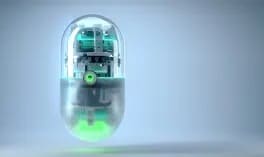
Nanomedicine is a branch of medicine that uses nanotechnology's knowledge and skills to prevent and treat illnesses. Nanomedicine is the use of tiny materials in living organisms for diagnosis, distribution, sensing, or actuation, such as biocompatible nanoparticles and nanorobots.
The innovative idea that tiny nanorobots and associated machinery may be created, manufactured, and delivered into the human body to perform cellular repairs at the molecular level gave birth to the concept of nanomedicine. Today, nanomedicine has taken hundreds of diverse courses, each of which embodies the basic understanding that the ability to build materials and devices at the molecular scale can provide huge immediate benefits in medical research and treatment.
Nanomedicine is an effective cancer treatment approach. A PEGylated liposomal formulation of doxorubicin was the first clinically authorized nanomedicine. There have been 15 anticancer nanodrugs approved and utilized in clinical trials to date. Nanomedicines are unique in their ability to cure cancer because of their nanoscale sizes, high surface/volume ratio, controlled drug release at the targeted region, protection from enzymatic and mechanical degradation, and addition of additives that enable drug solubilization. Liposomes, polymer, lipid nanocapsules and nanoparticles, polymer-drug conjugates, and Pluronic micelles are all examples of nanoparticles that have been employed in cancer therapy.
The following are some general principles of nanotechnology as they apply to nanomedicine:
1. Biomimicry is the process by which cells move molecules within their own cells and/or molecules/machines to the appropriate cells in the body.
2. Biocompatibility and biological effectiveness are influenced by size and location.
3. Integrate therapeutic systems with feedback control (e.g., therapeutic gene synthesis).
4. Molecules as machines: modify cell and organism behavior by engineering molecules to execute certain physical functions, such as opening ion channels.
5. Intelligent design-based "pseudointelligence," such as the self-assembly of extracellular matrix (ECM) molecules.
6. Nanotechnology creation is a highly interdisciplinary endeavor that often requires knowledge in biology, engineering, chemistry, and physics.
Nanomedicines of the Future
The growth of nanomedicine has resulted in the development of hybrid nanomedicines, imaging agents, and diagnostic agents. Technological advancements have cleared the road for nanomedicines to be improved even more. Nanomedicines are currently being used as a platform for delivering siRNA or miRNA. The RNase present in physiological fluids degrades these RNAi, making them unstable. As a result, nanocarriers encapsulate such RNAi, protecting them from RNase degradation while also enhancing targeting specificity and stability. Exosomes, fusion proteins, and RNAi nanoparticles are the most recent nano therapy breakthroughs. Nanosimilars are a follow-up to a reference nanomedicine product.
The scale and methods of vascular imaging and medicine delivery are beginning to alter because of nanotechnology. Nanoscale technologies will begin to deliver more medical benefits within the next 10 years, according to the NIH Roadmap's 'Nanomedicine Initiatives.' This covers the creation of nanoscale diagnostic and drug discovery platform devices such as nanoscale cantilevers for chemical force microscopes, microchip devices, nanopore sequencing, and so on. Similarly, the National Cancer Institute is working on nanometer-scale multifunctional entities that can diagnose cancer, distribute therapeutic chemicals, and track treatment progress.
Nanomedicine: Promises and Challenges:
Pathophysiological challenges:
Nanomedicines are made using a formulation strategy, but innovative delivery systems are evaluated using physicochemical characteristics. There are obstacles in clinical translation when researchers want to combine nanomedicine with pathological applications. If we can comprehend the interaction between technology and biology, we can understand elements of accumulation efficiency dispersion of the nanomedicine within the pathophysiological state as well as we can find the relationship of pharmaceutical chemicals in animals and humans. As a result, they have the potential to be a successful clinical translation of nanomedicine. It's also important to understand the pharmacological relationship between in vivo behavior and delivery mechanism. It is advised that clinical translation be improved to build and design nanomedicine that can survive in pathophysiological settings.
Government regulations:
Nanomedicines have shown great growth potential in the pharmaceutical sector and enhanced patient health benefits, but there is a significant gap between scientific and regulatory fields, which is difficult to bridge. Many regulatory factors that are dependent on government policies in the areas of manufacturing practices, quality control, safety, and patent protection have a substantial impact on nanomedicine commercialization. The lack of clear regulatory and safety criteria has hampered fast and successful clinical translation. Similarly, in the case of NNMs, polymers are being examined as a potential platform for the development of nanomedicines, however, polymer safety and efficacy are mostly determined by the molecular structure and molecular weight of the polymer, conjugation chemistry, and polydispersity.
The establishment of a suitable regulatory framework is an immediate demand since the number of novel polymeric materials and complex polymeric NNM formulations grows by the day. Because each nanomedicine is unique, it is critical that each one be examined in terms of method of administration, dosage frequency, suggested therapeutic usage, and at various concentrations. In current practice, NNMs are regulated using a standard framework that is adopted by relevant regulatory authorities in each nation, such as the FDA and the EMA (e.g., FDA, TGA, and EMA). Despite having been on the market for decades, the first NNM products were approved solely based on meeting the broad standards that apply to traditional pharmaceutical substances.